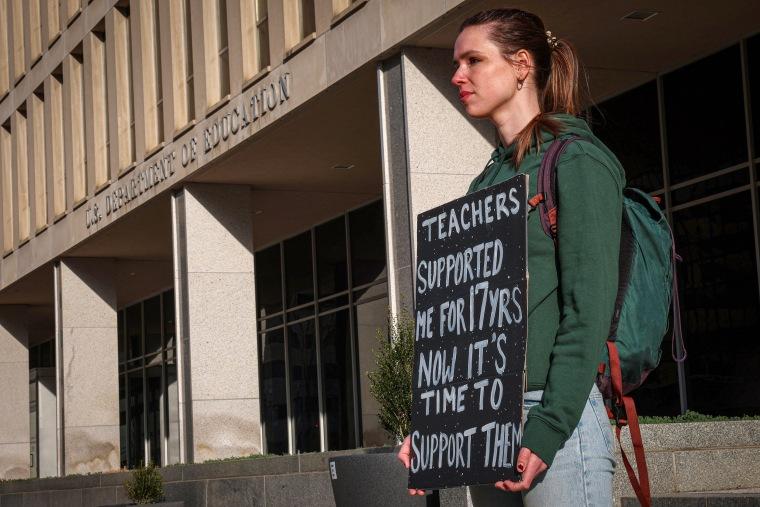The U.S. Department of Education has announced a series of layoffs, raising urgent questions about the future management of student loans. As the agency faces staffing reductions amidst ongoing efforts to overhaul federal student loan programs, borrowers and stakeholders are closely watching for how these changes will impact loan servicing, repayment options, and borrower assistance. This development comes at a critical time when millions of Americans depend on federal student aid, making the implications of the layoffs a focal point for both policymakers and the public.
Department of Education Workforce Reduction Raises Concerns Over Loan Servicing Delays
The recent workforce reduction at the Department of Education has sparked significant concern among borrowers and advocacy groups. With fewer employees handling the backlog, many fear that loan servicing will experience further delays, especially as the department navigates increasing volumes of inquiries and requests. Critical services such as repayment plan adjustments, loan forgiveness applications, and customer support may face longer processing times, potentially impacting millions of students nationwide.
Industry experts highlight several immediate challenges resulting from the staffing cuts:
- Extended wait times: Borrowers report difficulty reaching representatives by phone or online platforms.
- Processing bottlenecks: Delays in verifying eligibility for forgiveness programs are expected to rise.
- Heightened administrative burden: Remaining staff will need to manage larger caseloads with reduced resources.
| Impact Area | Potential Outcome |
|---|---|
| Repayment Adjustments | Longer approval timelines |
| Customer Service | Increased call wait times |
| Loan Forgiveness | Slower application processing |
Impact on Borrowers: What Students Should Expect Amid Staffing Shortages
Students relying on federal student loans should prepare for potential delays in customer service and loan processing. With fewer staff members available, response times for inquiries and requests for repayment assistance may increase significantly. Borrowers may also experience longer wait times when seeking help with loan forgiveness applications or deferment options, adding uncertainty during an already stressful financial period. It’s essential for borrowers to explore self-service options online and keep detailed records of any communications with loan servicers.
In addition to service delays, there could be delays in the disbursement of funds or the updating of account statuses. To better understand what borrowers might face, here’s a snapshot of possible impacts:
| Service Area | Potential Impact | What Borrowers Can Do |
|---|---|---|
| Customer Support | Longer hold times and slower email responses | Use FAQs and online portals for common questions |
| Loan Processing | Delays in application approvals and status updates | Check loan status regularly via official websites |
| Repayment Plans | Slower adjustments to income-driven repayment plans | Submit documentation early and keep copies |
| Forgiveness Programs | Extended review periods for eligibility and certifications | Stay informed on program requirements and deadlines |
Expert Analysis on Federal Loan Management and Potential Policy Adjustments
Federal loan management is facing an unprecedented challenge as the Department of Education prepares for significant workforce reductions. Experts warn that these layoffs could slow critical processes such as application processing, loan servicing, and borrower assistance programs. Stakeholders are particularly concerned about potential delays in loan forgiveness applications and the administration of income-driven repayment plans, which millions of borrowers depend on. Industry analysts emphasize the importance of maintaining operational continuity to prevent a backlog that could affect both new and existing borrowers.
The ripple effects of these changes could also lead lawmakers to reevaluate current student loan policies. Some policy experts suggest that the layoffs might catalyze a push for:
- Automation and digital infrastructure improvements to compensate for reduced manpower.
- Legislative reforms aimed at streamlining federal student loan programs.
- Enhanced support frameworks for distressed borrowers facing delays.
As federal officials navigate this transition, close monitoring of implementation timelines and borrower impact will be critical to minimizing disruption in the student loan ecosystem.
Strategies for Borrowers to Navigate Student Loan Payments During Transition Period
As federal employees face layoffs, borrowers should proactively review their student loan portfolios to avoid disruptions. Staying informed through official Department of Education communications and leveraging tools like the Federal Student Aid website can help borrowers keep track of payment deadlines, interest rates, and any changes to borrower benefits. Setting up automatic payments or enrolling in income-driven repayment plans may also provide added stability during this uncertain period.
Additionally, consider these strategic steps to maintain control over your repayment journey:
- Contact loan servicers early to discuss options if financial hardship arises.
- Keep copies of all correspondence and payment records for reference.
- Explore federal relief programs such as deferment, forbearance, or temporary suspension of payments when eligible.
- Monitor legislative updates that may impact loan forgiveness or repayment terms.
| Action | Benefit | Recommended Timing |
|---|---|---|
| Set Up Auto-Pay | Avoid missed payments and late fees | Immediately |
| Enroll in Income-Driven Plan | Adjust payments based on income fluctuations | Before transition period ends |
| Request Forbearance | Temporary payment relief | When facing immediate financial hardship |
| Stay Informed | Adapt to policy changes quickly | Ongoing |
Closing Remarks
As the Department of Education moves forward with its planned layoffs, uncertainty looms over the future management of student loans and borrower services. Stakeholders across the education sector, including borrowers and advocacy groups, are closely monitoring developments, hoping for clear guidance on how these changes will impact loan processing, repayment options, and overall customer support. With millions of Americans relying on federal student aid, the coming months will be critical in determining how the department adapts to staffing reductions while continuing to serve the needs of borrowers nationwide. The Houston Chronicle will continue to provide updates as more information becomes available.




